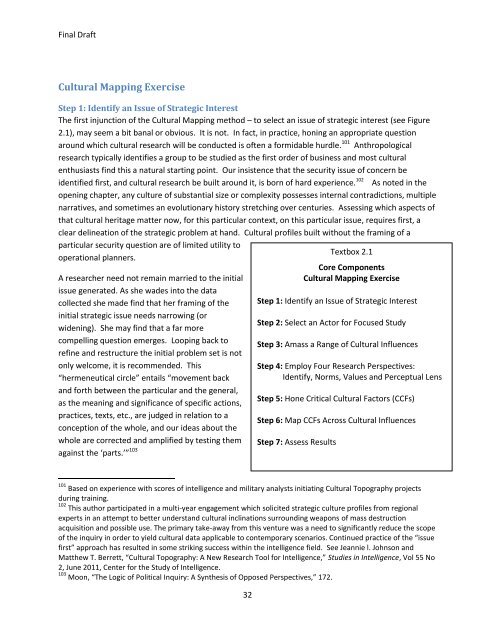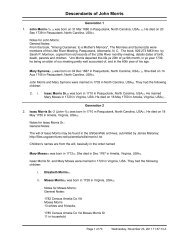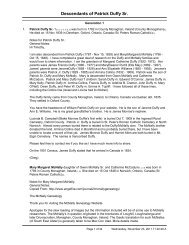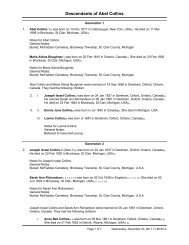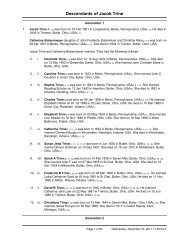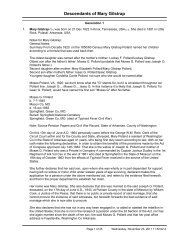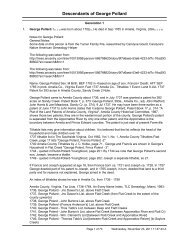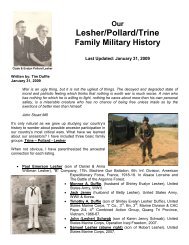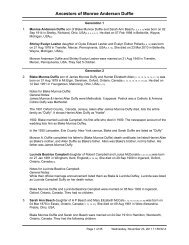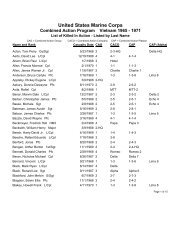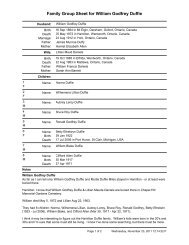Assessing the Strategic Impact of Service Culture on ...
Assessing the Strategic Impact of Service Culture on ...
Assessing the Strategic Impact of Service Culture on ...
Create successful ePaper yourself
Turn your PDF publications into a flip-book with our unique Google optimized e-Paper software.
Final Draft<br />
Cultural Mapping Exercise<br />
Step 1: Identify an Issue <str<strong>on</strong>g>of</str<strong>on</strong>g> <str<strong>on</strong>g>Strategic</str<strong>on</strong>g> Interest<br />
The first injuncti<strong>on</strong> <str<strong>on</strong>g>of</str<strong>on</strong>g> <str<strong>on</strong>g>the</str<strong>on</strong>g> Cultural Mapping method – to select an issue <str<strong>on</strong>g>of</str<strong>on</strong>g> strategic interest (see Figure<br />
2.1), may seem a bit banal or obvious. It is not. In fact, in practice, h<strong>on</strong>ing an appropriate questi<strong>on</strong><br />
around which cultural research will be c<strong>on</strong>ducted is <str<strong>on</strong>g>of</str<strong>on</strong>g>ten a formidable hurdle. 101 Anthropological<br />
research typically identifies a group to be studied as <str<strong>on</strong>g>the</str<strong>on</strong>g> first order <str<strong>on</strong>g>of</str<strong>on</strong>g> business and most cultural<br />
enthusiasts find this a natural starting point. Our insistence that <str<strong>on</strong>g>the</str<strong>on</strong>g> security issue <str<strong>on</strong>g>of</str<strong>on</strong>g> c<strong>on</strong>cern be<br />
identified first, and cultural research be built around it, is born <str<strong>on</strong>g>of</str<strong>on</strong>g> hard experience. 102 As noted in <str<strong>on</strong>g>the</str<strong>on</strong>g><br />
opening chapter, any culture <str<strong>on</strong>g>of</str<strong>on</strong>g> substantial size or complexity possesses internal c<strong>on</strong>tradicti<strong>on</strong>s, multiple<br />
narratives, and sometimes an evoluti<strong>on</strong>ary history stretching over centuries. <str<strong>on</strong>g>Assessing</str<strong>on</strong>g> which aspects <str<strong>on</strong>g>of</str<strong>on</strong>g><br />
that cultural heritage matter now, for this particular c<strong>on</strong>text, <strong>on</strong> this particular issue, requires first, a<br />
clear delineati<strong>on</strong> <str<strong>on</strong>g>of</str<strong>on</strong>g> <str<strong>on</strong>g>the</str<strong>on</strong>g> strategic problem at hand. Cultural pr<str<strong>on</strong>g>of</str<strong>on</strong>g>iles built without <str<strong>on</strong>g>the</str<strong>on</strong>g> framing <str<strong>on</strong>g>of</str<strong>on</strong>g> a<br />
particular security questi<strong>on</strong> are <str<strong>on</strong>g>of</str<strong>on</strong>g> limited utility to<br />
operati<strong>on</strong>al planners.<br />
A researcher need not remain married to <str<strong>on</strong>g>the</str<strong>on</strong>g> initial<br />
issue generated. As she wades into <str<strong>on</strong>g>the</str<strong>on</strong>g> data<br />
collected she made find that her framing <str<strong>on</strong>g>of</str<strong>on</strong>g> <str<strong>on</strong>g>the</str<strong>on</strong>g><br />
initial strategic issue needs narrowing (or<br />
widening). She may find that a far more<br />
compelling questi<strong>on</strong> emerges. Looping back to<br />
refine and restructure <str<strong>on</strong>g>the</str<strong>on</strong>g> initial problem set is not<br />
<strong>on</strong>ly welcome, it is recommended. This<br />
“hermeneutical circle” entails “movement back<br />
and forth between <str<strong>on</strong>g>the</str<strong>on</strong>g> particular and <str<strong>on</strong>g>the</str<strong>on</strong>g> general,<br />
as <str<strong>on</strong>g>the</str<strong>on</strong>g> meaning and significance <str<strong>on</strong>g>of</str<strong>on</strong>g> specific acti<strong>on</strong>s,<br />
practices, texts, etc., are judged in relati<strong>on</strong> to a<br />
c<strong>on</strong>cepti<strong>on</strong> <str<strong>on</strong>g>of</str<strong>on</strong>g> <str<strong>on</strong>g>the</str<strong>on</strong>g> whole, and our ideas about <str<strong>on</strong>g>the</str<strong>on</strong>g><br />
whole are corrected and amplified by testing <str<strong>on</strong>g>the</str<strong>on</strong>g>m<br />
against <str<strong>on</strong>g>the</str<strong>on</strong>g> ‘parts.’” 103<br />
32<br />
Textbox 2.1<br />
Core Comp<strong>on</strong>ents<br />
Cultural Mapping Exercise<br />
Step 1: Identify an Issue <str<strong>on</strong>g>of</str<strong>on</strong>g> <str<strong>on</strong>g>Strategic</str<strong>on</strong>g> Interest<br />
Step 2: Select an Actor for Focused Study<br />
Step 3: Amass a Range <str<strong>on</strong>g>of</str<strong>on</strong>g> Cultural Influences<br />
Step 4: Employ Four Research Perspectives:<br />
Identify, Norms, Values and Perceptual Lens<br />
Step 5: H<strong>on</strong>e Critical Cultural Factors (CCFs)<br />
Step 6: Map CCFs Across Cultural Influences<br />
Step 7: Assess Results<br />
101<br />
Based <strong>on</strong> experience with scores <str<strong>on</strong>g>of</str<strong>on</strong>g> intelligence and military analysts initiating Cultural Topography projects<br />
during training.<br />
102<br />
This author participated in a multi-year engagement which solicited strategic culture pr<str<strong>on</strong>g>of</str<strong>on</strong>g>iles from regi<strong>on</strong>al<br />
experts in an attempt to better understand cultural inclinati<strong>on</strong>s surrounding weap<strong>on</strong>s <str<strong>on</strong>g>of</str<strong>on</strong>g> mass destructi<strong>on</strong><br />
acquisiti<strong>on</strong> and possible use. The primary take-away from this venture was a need to significantly reduce <str<strong>on</strong>g>the</str<strong>on</strong>g> scope<br />
<str<strong>on</strong>g>of</str<strong>on</strong>g> <str<strong>on</strong>g>the</str<strong>on</strong>g> inquiry in order to yield cultural data applicable to c<strong>on</strong>temporary scenarios. C<strong>on</strong>tinued practice <str<strong>on</strong>g>of</str<strong>on</strong>g> <str<strong>on</strong>g>the</str<strong>on</strong>g> “issue<br />
first” approach has resulted in some striking success within <str<strong>on</strong>g>the</str<strong>on</strong>g> intelligence field. See Jeannie l. Johns<strong>on</strong> and<br />
Mat<str<strong>on</strong>g>the</str<strong>on</strong>g>w T. Berrett, “Cultural Topography: A New Research Tool for Intelligence,” Studies in Intelligence, Vol 55 No<br />
2, June 2011, Center for <str<strong>on</strong>g>the</str<strong>on</strong>g> Study <str<strong>on</strong>g>of</str<strong>on</strong>g> Intelligence.<br />
103<br />
Mo<strong>on</strong>, “The Logic <str<strong>on</strong>g>of</str<strong>on</strong>g> Political Inquiry: A Syn<str<strong>on</strong>g>the</str<strong>on</strong>g>sis <str<strong>on</strong>g>of</str<strong>on</strong>g> Opposed Perspectives,” 172.


